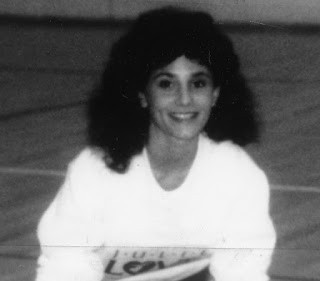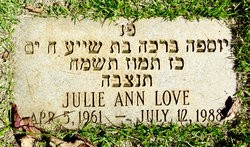
Ask any person who lived in Atlanta in 1988 if they remember Julie Love and I guarantee you?ll get an answer in the positive. While today the news is saturated with missing persons and general negativity, in 1988 such cases seemed more isolated and the general belief was they certainly didn?t happen in safe neighborhoods. Julie Love was a 27-year-old fitness instructor, a teacher of children, a former cheerleader and gymnast, on July 11, 1988. She was newly engaged (only weeks) to her longtime boyfriend and both lived in Buckhead, an affluent neighborhood of Atlanta. She had run out of gas after attending a business meeting that Monday evening and left her car , a red Mustang convertible, on Dover Road. Since she was only half a mile from both her fianc?s residence and a gas station she set out on foot for one or the other. She never reached either. Her family and friends quickly banded together to speak to the media and pepper the area with posters of a smiling Julie captioned ?Have You Seen Julie Love?? The entire city seemed to be in lockdown, everyone desperately searching to find Julie and bring her home. There was also an underlying cold fear, one that led women to look over their shoulders and go everywhere in pairs or groups. If Julie Love could go missing on a warm summer evening while it was still light outside, in a safe and well-to-do area of town, no one was safe.

Atlanta was a city that was known for its crime issues. It had led the nation in murder statistics in the early part of the decade, uneasily taking the title of the ?Murder Capital of the U.S.?, as well as racial tensions. Another reason the Julie Love disappearance scared so many was the fact that Julie disappeared from an area that was primarily Caucasian, not one of the areas closer to the city that were populated by minorities and therefore assumed to be more dangerous. Julie?s disappearance managed to garner national attention and despite a reward offered by the Love family and hundreds of tips, including leads given by psychics, months slipped by without a trace of her. Not knowing what had happened to her made the fear even more palpable for Atlanta and must have been unbearable for her Julie?s loved ones.
Thirteen long months after her disappearance, following reported sightings as far away as California and Canada, investigators got their first tangible break. A woman by the name of Janice Weldon contacted the Fulton County PD on July 28, 1989 to tell them that a man by the name of Emmanuel Hammond, in jail on an armed robbery charge, was guilty of abducting and killing Julie Love. Janice, a stripper and Hammond?s ?companion,? was afraid that Hammond would kill her for what she knew? and with good reason. Hammond had offered a cellmate $20,000, a car, and a job to kill his girlfriend because she knew too much. That fear incited Janice to contact authorities, where she shared what she had known for over a year. She stated that she, Hammond and Hammond?s cousin, Maurice Porter, were driving down Howell Mill Road on July 11, 1988 when they spotted Julie walking alone shortly after 9:30 p.m. They pulled over and asked her if she needed a ride. She responded in the negative and pointing to a home, said she lived there before heading up the driveway. The trio drove off but Hammond, looking in either his side or rearview mirror, noticed her turn and head back on the road. He also noticed the red Mustang farther up the street and correctly deduced it was her disabled car. They turned around, putting their bright lights on, and approached Julie. Hammond jumped out with a sawed off shotgun, hit her and pushed her into the car. She was taken to an elementary school, where she gave them her ATM cards; Hammond claimed he wanted the money in order to buy drugs. Their attempts to withdraw money at an ATM failed, as the number Julie gave them didn?t work and the machine took the cards, making Hammond furious. It was at that point that Porter raped Julie.
Julie offered up more cards that she had at home. The car carrying Julie, Hammond, Janice, and Porter headed toward Julie?s apartment only to turn away when they saw a security guard at the entrance. At this point, after Hammond again struck Julie, that Janice decided she had had enough and demanded to be taken home. After she was dropped off, Julie, Hammond and Porter went to the Grove Park Place area off Johnson Road in northwest Atlanta where there was an abandoned dump. Julie?s hands and feet were tied and she was cloaked in a sheet. A wire coat hanger was wrapped around her neck, with Hammond and Porter each pulling on one end. However, Julie fought back and her assailants found the wire hanger was not the most effective means of tying up their loose ends. Porter stayed at the car while Hammond marched Julie off toward the wooded area, where shortly after he heard a single gunshot. The next day Janice asked Hammond what had become of Julie. He replied that Julie had put her hand up in front of her face in a defensive motion and he had blown it and half her face off. Nice guy. Amazingly, not only did Janice ride along quite willingly during the abduction and the attempt to take money from ATM machines, as well as being present during Julie?s rape, but she didn?t immediately go to the police upon finding out that Julie had been killed. Only when she felt her own life was in danger did she spill all, finally letting authorities and Atlantans know what had happened to Julie. A search of the area led investigators to Julie?s physical remains, hidden among weeds and trash. Janice was given immunity in exchange for her testimony against Hammond and Porter. Porter was spared the death penalty by making a guilty plea to murder, rape and armed robbery. He was sentenced to two consecutive life sentences. Hammond was convicted in 1990 after an 11-day trial and sentenced to death.
 Hammond, executed
Hammond, executed
Sadly and frustratingly, it would be nearly 23 painful years after Julie?s murder before justice was delivered to her killer. In 1993, Hammond would begin the first of his five state level appeals for his conviction. In 2003 he would file the first of seven federal level appeals. All were denied. Fifteen days before his execution, Hammond filed a writ of certiorari in the Supreme Court. It was a last ditch effort to stave off execution and the writ was denied.
 Porter, still incarcerated
Porter, still incarcerated
On January 25, 2011, Emmanuel Hammond was executed by the state of Georgia for abducting and murdering Julie Love. The execution was somewhat unusual in that Hammond had very few anti-death penalty groups on his side; most people were quite glad that legal justice was finally being carried out. The execution closed a chapter of Atlanta history. Julie Love was very much a part of the fabric of the 1980s for Atlanta. No longer did women feel as carefree in nice neighborhoods and much more care was taken to keep vehicles from running out of fuel. Julie did what we were all instructed to do: never take a ride with strangers and if you feel threatened, go to the first house. It nearly saved her. If only she had knocked on that door or waited another moment before heading back to the street. If only Hammond had not looked back. If only. Had she lived, Julie would be 59 years old today.


